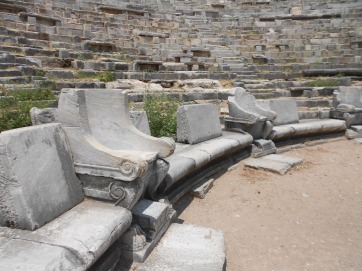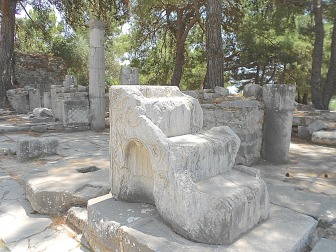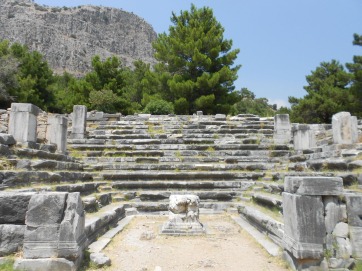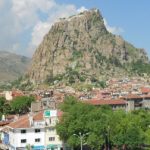Seat of the Panionic League
High on Samsun Dağı (Mt Mykale, 1273m) overlooking the floodplain of the Büyük Menderes river stand the remains of the Temple of Athena at Priene in the part of Turkey that was known in antiquity as Ionia. Designed by Pytheos of Halicarnassus in the mid-fourth century BC, it was regarded as one of the most perfect examples of an Ionian-style temple in its heyday.
Today its five re-erected columns are the most striking relic of a small town founded around 300 BC that went on to host the annual meetings of the Panionic League, a confederation of 12 city-states that was once hugely important.
This is a site that is as beautiful for its setting as for the wonder of its ruins. Allow plenty of time to do it justice – there are a couple of simple cafes where you can stock up on drinks and refresh yourself afterwards just beside the minibus stop at the foot of the slope leading up to the site.
Around the site
Priene was originally founded by refugees from Athens in the 11th century BC, but their first settlement was on lower ground and has now vanished beneath the silt deposited by the river.
Over time their descendants moved slowly upwards, building their final city on terraces on the mountainside, and following the grid-plan layout devised by Hippodamos, an architect from nearby Miletus. Within this grid plan houses were laid out with four to every so-called insula (island).
Since the site was later abandoned rather than built over, archaeologists have been able to study these houses in detail, and have concluded that they probably resembled the villas of Pompeii and Herculaneum in Italy. Corridor entrances led through to a central courtyard with rooms opening off it on each side. The staircases that sporadically survive also suggest that some of the houses would have been two storeys high. Front-row seats at Priene theatre
Front-row seats at Priene theatre
In its prime Priene had a population of perhaps 5,000, all of whom could have been accommodated in the town’s dinky theatre with its neatly tiered rows of seats. The most important local dignitaries got literal front-row seats, in this case marble thrones with lion’s-claw footrests.
Aside from the temple and the theatre other identifiable structures include the remains of a square bouleterion with tiered seating on three sides and a prytaneion right beside it where a sacred fire was kept burning and important visitors were entertained. There are also slight remains of a Temple of Asclepius, the god of medicine whose shrine at Bergama was so important.
Already overtaken in importance by Miletus in Roman times, Priene survived as the seat of a bishopric through the Byzantine era, after which it fell into slow decline. The ruins at the site include those of a fine Byzantine church dating back to the 6th century with a free-standing stepped pulpit (ambo), carved marble screens and a synthronon in the apse that was built right up against the wall of the huge Roman bathhouse.
Today the modern village of Güllübahçe lies scattered to the east, alongside the abandoned settlement of Eski Güllübahçe which lost the Greek population for whom its huge church was built in the population exchange of 1924.
Sleeping
Priene Pension. Close to site but sometimes full with archaeologists in summer. Tel: 0256-547 1725
Transport info
Dolmuşes to Priene/Güllübahçe leave from Söke, the regional transport hub for this part of the coast. To get between Priene and the other local ruins at Miletus and Didyma will involve back-tracking to Söke; signing up for a “PMD” tour taking in all three sites out of Selçuk or Kuşadası will be much easier if you don’t have a car.
There are regular dolmuşes to Söke from Selçuk and Kuşadası.
 Remains of Bishop’s Basilica with ambo in centre
Remains of Bishop’s Basilica with ambo in centre
 Remains of bouleterion at Priene
Remains of bouleterion at Priene


